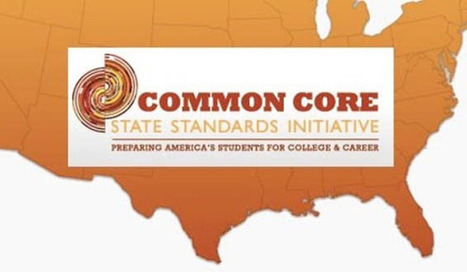 Your new post is loading...
 Your new post is loading...

|
Scooped by
Mel Riddile
December 21, 2011 10:50 AM
|
Welcome to Getting Ready, a site with information and resources for transition to the Montana Common Core Standards and The Smarter Balanced Assessment Consortium.

|
Scooped by
Mel Riddile
December 21, 2011 9:49 AM
|
Wyoming lawmakers have thrown their support behind proposed state standards based on national standards adopted by 45 other states and the District of Columbia.
Reasons for CCSS Support:
More Rigorous
About 70 educators and parents around the state reviewed the national standards and generally said they were more rigorous than existing Wyoming content standards.
College and Career-Ready
“If you want kids to be college and career ready, you have to have standards that articulate what it means to be college and career ready."
Comparability
“And if you want to be compared — favorably I hope — to other states, you have to have a basis for that comparison.”
Share Resources
“A company is not going to write a textbook aligned to just Wyoming standards,” Marion said. “They’re going to write to common core standards, and you want to have materials that represent what your teachers are teaching.”
Improvement over current state standards
Lawmakers said that among all the complaints they heard about the common core from constituents, none said current Wyoming standards were better.
“I’m not hearing a defense of the Wyoming content standards by anybody,” said Sen. Phil Nicholas, R-Laramie.

|
Scooped by
Mel Riddile
December 20, 2011 10:55 AM
|
Dr. King said the move to longer testing times was part of the state’s efforts to fine-tune tests of student performance. The tests will, for the first time in 2012, include questions that will not count toward a student’s score, but will be used to develop future tests (Common Core State Standards). At three hours, New York’s tests will still be shorter than those given in many other states, where they range from two and a half to four and a half hours. Nevertheless, the increase in testing times drew sharp criticism Monday from many school administrators, teachers and parents.

|
Scooped by
Mel Riddile
December 20, 2011 9:48 AM
|
Essential Question: When studying a story or an essay, is it possible to be too concerned with what the author is saying? In an opinion piece in Education Week, Maja Wilson and Thomas Newkirk complain the publisher’s criteria for Common Core State Standards are overly “text dependent,” discouraging students from bringing their own knowledge and opinions to bear on their reading. Summary: What often gets lost in our rush to engage young readers and make their reading personally relevant is the simple fact that text has communicative value. When someone commits words to print, they mean to communicate facts, ideas, imagery or opinions. They should expect, if they’ve done their job well, to be understood. Might the reader have a response? Let’s hope so. But unless they have understood the author’s words and intent clearly, any response they make is less than satisfying and may not be particularly relevant as a “response.” The bottom line: Demonstrating comprehension based on what a text says is not a problem. It’s a baseline skill for any literate human being. A Little More Text, A Little Less Self
by Robert Pondiscio
December 19th, 2011 Core Knowledge Blog http://blog.coreknowledge.org/2011/12/19/a-little-more-text-a-little-less-self/

|
Scooped by
Mel Riddile
December 19, 2011 4:16 PM
|
A collection of Common Core Resources geared towards Utah teachers.

|
Scooped by
Mel Riddile
December 19, 2011 12:09 PM
|
Damon Gardenhire, communications director for Oklahoma Superintendent of Public Instruction Janet Barresi, asserts high cost estimates for implementation of the Common Core are inaccurate. In addressing the issue, the agency has stressed Barresi’s distinctions between “curriculum” and “standards” in terms of the “common core” of subject matter mastery or awareness in public schools. At least in terms of Oklahoma, the agency leadership contends estimates of high development and implementation costs are “a red herring.”

|
Scooped by
Mel Riddile
December 16, 2011 11:20 AM
|
If you were unable to attend the MASSP High School and CTE Mid-Winter Summit, you missed an opportunity to learn some key information. We were fortunate to have Mel Riddile provide a keynote session on the changes we can expect as we transition to the Common Core Standards. John Carroll from ACT also shared a number of important updates. Highlights on Common Core: - Mel explained that the transition to the Common Core is a 2nd order change.
- Employment and college readiness statistics support the need to increase rigor in our curriculum. Rigor = Content + Higher Order Thinking Skills + Application.
- The common core is internally benchmarked for success in a global economy and it is research and evidence based.
- For every 10 students who enter college - fewer than 2 will graduate with a 2 or a 4 year degree.
Common Core assessments will be implemented in 2015. These assessments are supposed to be online and they create significant logistical challenges.

|
Scooped by
Mel Riddile
December 15, 2011 11:36 AM
|
The days of Algebra I, Algebra II and Geometry could be numbered in Triangle schools, but they would be replaced by a new trio of what's supposed to be tougher and more in-depth math courses.

|
Scooped by
Mel Riddile
December 15, 2011 9:19 AM
|
"In a country as large and diverse as ours there is no single, right set of knowledge for all students to possess, no single, best way to assess that knowledge, and no single, best method for teaching it. The attempt to impose a nationalized system onto this diversity is doomed to fail just as the Euro is doomed to fail in imposing a common currency on such diverse economies and political systems."

|
Scooped by
Mel Riddile
December 13, 2011 4:29 PM
|
So why is the common core making such a big deal out of having kids read hard text? Because... "Test performance is driven by text rather than questions." In Reading: Between the Lines, ACT demonstrates that student performance cannot be differentiated in any meaningful way by question type. Students do not perform differently if they are answering literal recall items or inferential items (or other question types like main idea or vocabulary, either). Test performance, according to ACT, is driven by text rather than questions. Thus, if students are asked to read a hard passage, they may only answer a few questions correctly, no matter what types of questions they may be. On the other hand, with an easy enough text, students may answer almost any questions right, again with no differences by question type. Dr. Tim Shanahan, a member of the CCSS development team, has some particularly interesting insights into the thinking behind the standards. In the video above, watch him speak about the shift from a skills-focused approach in state standards to the emphasis on complex text in the Common Core State Standards.

|
Scooped by
Mel Riddile
December 12, 2011 5:14 PM
|
via Education Daily December 12, 2011 Education policy analysts in a recent report on high school exit exams questioned what the future of high school assessment policies will look like when a new assessment system tied to the Common Core State Standards is put in place in SY 2014-15. Several states have expressed plans to replace their current math and English/language arts exit exams with tests developed by two state consortia, the Partnership for Assessment of Readiness for College and Careers and the SMARTER Balanced Assessment Consortium. Analysts said uncertainty lies ahead for high school testing policies, as states decide how adoption of uniform assessments might impact current state requirements. “With a state assessment that measures students’ college- and career-readiness, as both the PARCC and SMARTER Balanced assessments intend to do, will there be a need for mandated ACT and SAT testing or for existing college and career readiness assessment policies?,” they wrote. “In other words, can states, or will states, eliminate or consolidate their assessment policies in order to streamline their assessments system tied to the [Common Core]?” According to State High School Tests: Changes in State Policies and the Impact of the College and Career Readiness Movement, 27 of the 31 states with current or planned exit exams reported participating in one or both of these state consortia to develop common assessments that are aligned to new benchmarks. At least 16 out of the 27 states plan to replace their current exams with consortia assessments, and at least 16 states — though not necessarily the same ones — also expect the new assessments to be “more rigorous” than their current tests, the paper noted. Delaware was the only state responding that new assessments would be “about the same as” their current assessments, and Arkansas predicted they would be “no less rigorous,” it said.

|
Scooped by
Mel Riddile
December 8, 2011 11:32 AM
|
"The new Common Core Standards that promise to significantly enhance the academic rigor seen in American classrooms." Mike Casserly, Council of Great City Schools.

|
Scooped by
Mel Riddile
December 7, 2011 1:57 PM
|
No matter where you live, chances are it’s a Common Core state. In total, 45 states and the District of Columbia have adopted the Common Core and are developing plans to implement those standards over the next several years. While much of the work around implementation is taking place behind the closed doors of state education departments, the state Race to the Top applications and the more recent ESEA waivers provide a window into where states are prioritizing their time and focusing their resources. Not surprisingly, all states have some kind of plan to align curriculum, assessment, and professional development around these new standards. But it’s far from certain whether most states will get it right.
|

|
Scooped by
Mel Riddile
December 21, 2011 10:05 AM
|
West Hartford School District Dec. 21, 2011
School officials are "enthusiastic about the upcoming changes. Even though implementation of the Common Core State Standards requires revamping many parts of the district’s curriculum, they believe it will more actively engage both the teachers and the students."
What Not How - “The standards don’t tell us how to teach, they teach us what to teach.”
- “What we provide in curriculum design work is a framework. There’s plenty of room for teacher choice; it’s benchmarks and guideposts.”
- "this is a standards-based movement and the assessments are going to be built behind it. The teachers should find this very liberating. They’ve really been excited.”
ELA and Literacy
- Greater emphasis on reading not just in English class, but also in every other discipline including science, social studies, and technology education.
- The reading of non-fiction will figure prominently, as will persuasive writing.
Math
- New mathematics standards will emphasize “processes and proficiencies.”
Aligned Curriculum
- Progression through the standards for all disciplines will begin in kindergarten, and build throughout each grade level.
Assessments - The CMT and CAPT will be phased out once new assessments are implemented. The new assessments are scheduled to begin in 2014-2015 and will be given to students in grades 3-8 and 11. The class of 2016 (today’s 8th graders) will be the last to take the CAPT test their sophomore year, and will take the new assessments as juniors.
- Testing will take place over a 12-week period during the latter part of the school year, and will be computer-based. Students will not be tested all at the same time, and the actual test will differ based on the student’s performance, with questions becoming increasingly difficult as the student progresses. Results will be available in just two weeks, allowing teachers to focus on areas where the students may need assistance.
Students More Engaged - “It’s going to be good for kids; they’re going to have to work differently and harder,” Howley said.
- “The kids will feel more excited. They’ll be contributing more and engaged with the content of what they are learning,” said Vicinus.
The Bottom Line “We didn’t ask for this but we are excited about it,” said Superintendent Karen List. “It will help us to streamline some of the curriculum, and get rid of some of the things that are nice to do but don’t really add to the curriculum.”

|
Scooped by
Mel Riddile
December 20, 2011 3:26 PM
|
For the first time in a over 10 years, the Florida Board of Education has increased the proficiency “cut” scores for all levels of the FCAT reading and math exams. The change, adopted unanimously Monday morning, results from the state’s move to a new, more rigorous version of the FCAT.
Lower cut scores at lower grades painted unrealistic picture.
Educators argued in favor of higher scores at the lower grade levels, saying the passing marks were misaligned since the start of the FCAT. Elementary scores were too low, making it look as if larger numbers of students were at grade level than was realistic, they said, while the high school scores were too high, making it look as if kids became sudden failures on entering ninth grade.
Question: Will states be able to decide cut scores for proficiency on the Common Core State Standards?

|
Scooped by
Mel Riddile
December 20, 2011 10:38 AM
|
1. Alignment to Common Core standards. In June 2010, the State Board of Education voted unanimously to make Michigan one of 35 states to adopt Common Core State Standards. Today only 5 states, including Texas and Virginia, have failed to sign on to Common Core. A release accompanying that announcement explained the timing of the Common Core phase-in in Michigan: “Teachers will begin to provide instruction related to the standards by the fall of 2012. It is anticipated that students will be assessed on the Common Core Standards beginning in 2014.” “Instruction is working...with building leaders through elementary advisory and secondary department chairs to increase rigor and focus,” the district’s presentation stated.

|
Scooped by
Mel Riddile
December 19, 2011 4:28 PM
|
The best understanding of what works in the classroom comes from the teachers who are in them. That’s why these standards will establish what students need to learn, but they will not dictate how teachers should teach. Instead, schools and teachers will decide how best to help students reach the standards.

|
Scooped by
Mel Riddile
December 19, 2011 12:41 PM
|
More than one in five college freshmen end up taking at least one remediation course, according to federal estimates, but states are doing a better job of providing feedback to high schools about when they need to beef up course rigor, according to new data from the Data Quality Campaign. According to the DQC, 39 states give high schools feedback reports on how their graduates perform academically in postsecondary education. Of these, 28 states include information on the students who need to take remedial classes once they reach campus. For the most part, this information is limited to the students who stay in-state, at public universities; only a dozen states give high schools feedback on the 19 percent of high school graduates who attend out-of-state or private colleges.

|
Scooped by
Mel Riddile
December 19, 2011 9:47 AM
|
New Math Curriculum Matches Common Core The shift to Singapore math comes as the New Haven takes part in the Common Core State Standards Initiative, whereby districts and states are aligning assessments and curriculae to a new national standard. New Haven plans to overhaul its math and literacy curriculae by the 2014-15 school year, including the full implementation of Singapore math. The district chose the Singapore approach because it “matches so well” with the Common Core effort, Mathews said. Change the way we teach When it came time to help her first-graders through a tricky subtraction problem, Rosalie Carr reached for a new arsenal of colored chips, base-10 bars and mighty "number bonds." Not Knowing the Answer, but Finding and Explaining With Singapore math, kids are encouraged not to just spit out answers, but to talk about which strategies they use to arrive at the solution. Understanding not Memorization Before Singapore math, Carr said, she relied much more heavily on flashcards. Singapore math aims to have kids understand the relationship between numbers instead of just memorizing fast facts. 4 math initiatives in 9 years? In her nine years at New Haven public schools, this is the fourth math initiative Carr has tried out. She said it’s the best, so far. The pages of the textbook are cleaner, with more real-life images. And the pace of the year is a blessing, she said. Mastery over Coverage In the past, the district’s elementary math curriculum ran “a mile wide and inch deep,” said district math coordinator Ken Mathews in an interview. Teachers had to rush through a range of topics. “Now we’re putting on the brakes,” he said: Teachers are instructed not to move on from a unit until “everybody masters it.”

|
Scooped by
Mel Riddile
December 16, 2011 11:17 AM
|
TOWNSEND -- School Board members listened to a presentation on possible scheduling changes at North Middlesex Regional High School Monday night. For the last six years, the school has employed a block schedule of four, 87-minute classes per day over two semesters of six months. Elective classes run in quarters. Battye said it allows students to achieve high, but not grow well. Administrators have reviewed new cognitive and educational research, distributed a Visions and Values survey and looked into Common Core and Partnership for the Assessment of Readiness for College and Careers testing. PARCC testing, which will be implemented along with the Common Core in the state, requires four tests during the school year that, according to Battye, should show improvement. A schedule that carries disciplines throughout the school year, she said, would suit that better. Read more: http://www.nashobapublishing.com/pepperell_news/ci_19561469#ixzz1giOaLqcG

|
Scooped by
Mel Riddile
December 15, 2011 11:21 AM
|
Common Core Arkansas Welcome to the Arkansas Department of Education Common Core Home Page. The strategic plan, videos, documents, and resources will be updated as needed. Please note the posting/revision date for the most current information.

|
Rescooped by
Mel Riddile
from Common Core Online
December 15, 2011 9:07 AM
|
Dozens of educational leaders are at NC State's McKimmon Center to examine the nuts and bolts of implementing CCSS. Instructional specialists are leading discussion-based sessions focused on ways to make sure ...
Via Darren Burris

|
Scooped by
Mel Riddile
December 13, 2011 3:50 PM
|
Compare-Contrast, Cause-Effect, Problem-Solution: Common 'Text Types' in The Times Suggestions for helping students understand common expository "text structures" like cause and effect, compare and contrast and problem-solution that appear often in The Times. How does a bad economy affect businesses like Phoenix Decorating in Pasadena? We’re using this and other articles as models of writing about cause and effect. Go to related article » http://www.nytimes.com/2011/11/28/us/rose-parade-new-years-ritual-faces-rough-times.html

|
Scooped by
Mel Riddile
December 10, 2011 2:50 PM
|
Center on Education Policy via Huffington Post 12/9/11 "Fewer states are requiring students to pass high school exit exams to graduate, but more states are increasing standardized testing in college- and career-readiness assessment efforts, according to a report released Thursday." The report by the Center on Education Policy reveals that in the 2010-11 school year: - Fewer Barrier Exams - 25 states have or plan to implement policies that require students to pass end-of-grade or end-of-course exams to earn a high school diploma -- a figure down from 28 the year before. - Six more have or plan to implement exit exams that do not mandate a minimum passing standard for graduation. - Using State Scores In Calculation of Final Course Grade - Georgia, North Carolina and Tennessee changed their exit exam requirements that instead factor student scores from those tests into the student's final grade in a course required for graduation. - 65 percent of all public school students nationwide required to take exit exams for graduation in the 2010-11 school year, compared to 74 percent in 2009-10. - The trend is moving toward more testing tied to national standards that aim to prepare students for college and careers. - Of the 31 states that have or plan to implement exit exams, 27 are participating in national guidelines tied to the Common Core State Standards, and 16 of those states plan to replace their current exams with assessments tied to the Common Core. - Just one state -- Georgia -- actually uses high school exit exams in employee hiring and higher education applications. College-Readiness - But states are still struggling to keep up. A report last month revealed dismal history education standards in Texas, contributing to a low level of college readiness among the state's high school students. - In 2006, when the College Readiness Standards were created, 40 percent of Texas college students weren't prepared. Last year, 48 percent of those entering community college and 14 percent of incoming college freshmen needed remedial courses in at least one subject, and the gap is growing. National figures released in August echo the Texas readiness report: - Just 25 percent of ACT test-takers met college preparedness standards for English, math, reading and science, whereas nearly one-third didn't meet any of those standards. - New York's High School Progress Reports released in October revealed that just a quarter of students graduating from New York City high schools this year were prepared for college coursework, and fewer than half of all students enrolled in college four years after entering high school.

|
Scooped by
Mel Riddile
December 7, 2011 2:02 PM
|
Cartersville High School students began an online petition and Facebook page in hopes of remaining on a block schedule. Cartersville City Schools Assistant Superintendent Ken Clouse more than two weeks ago told Cartersville Patch the change is necessary due to the state's adoption of common core curiculum and new performance measures set to take effect in 2014. He said the move from a four-by-four block schedule to a traditional six- or seven-period plan would give students more instructional time over the course of a school year.
|
 Your new post is loading...
Your new post is loading...
 Your new post is loading...
Your new post is loading...





























